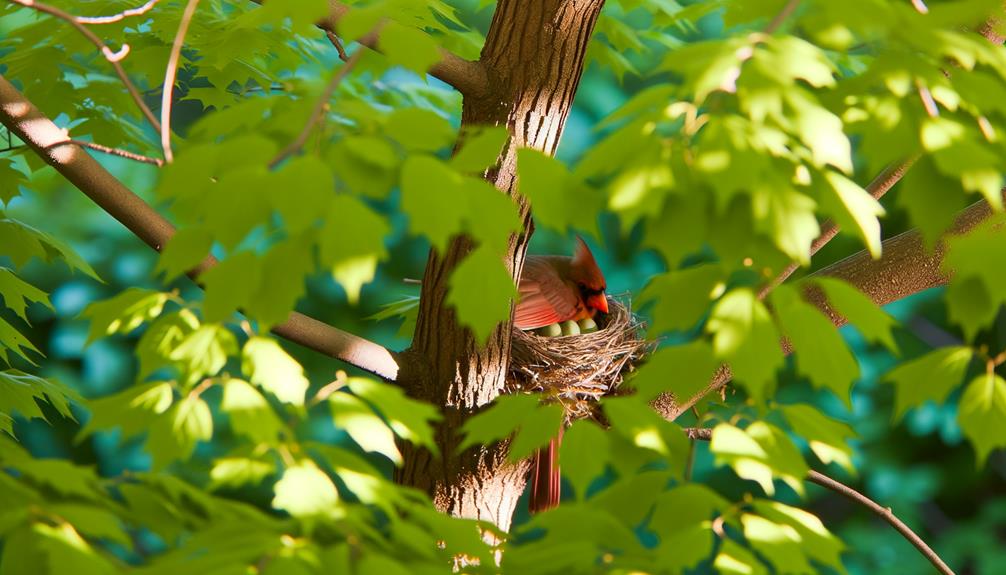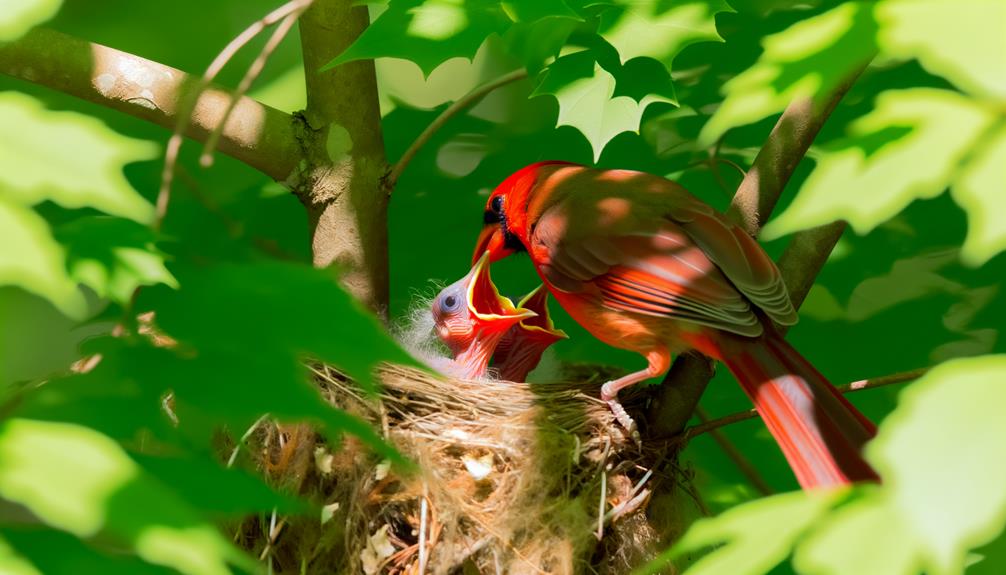How Long Do Cardinals Feed Their Young?
Cardinals feed their young roughly 8-10 times per hour, ensuring rapid growth. This intensive feeding lasts for about 9 to 11 days until the chicks are ready to fledge.
Both parents participate—males support by bringing food and guarding territory, while females dedicate themselves to feeding. High-frequency feedings provide essential proteins from insects, supporting muscle and feather development.
After fledging, young cardinals begin independent foraging, improving their survival skills. If you're curious about the detailed roles of each parent and the chick's development stages, there's more fascinating information to uncover.

Key Takeaways
- Cardinals feed their young every 15-20 minutes until they are nearly ready to fledge.
- Both parents feed the young cardinals 8-10 times per hour.
- Feeding continues intensively until the chicks are capable of foraging independently.
- The high-frequency feeding period lasts for about 9-11 days post-hatching.
- Parental feeding is crucial for the chicks' rapid growth and development before fledging.
Egg Laying and Incubation

Cardinals typically lay a clutch of three to four eggs, which the female incubates for about 12 to 13 days. You'll find that she remains dedicated to keeping the eggs warm, rarely leaving the nest.
The male supports her by bringing food and guarding the territory. The eggs, usually speckled and pale blue, require a stable, warm environment to maintain proper development.
During this period, the female's body heat is vital for maintaining the best temperature. You might notice how she carefully turns the eggs, ensuring even warmth. This meticulous care is important for the embryos' growth.
Hatching Process
As the incubation period concludes, you'll notice the eggs starting to crack open, signaling the beginning of the hatching process.
The tiny chicks use an egg tooth, a small, temporary structure on their beaks, to break through the shell. This challenging task can take up to 24 hours.
You'll observe that the hatchlings emerge wet and exhausted, but they quickly dry and gain strength. The mother cardinal typically assists by removing eggshell fragments from the nest.
The newborns are altricial, meaning they're entirely dependent on their parents. Their eyes remain closed, and they lack feathers, making them vulnerable.
This critical period requires close parental care to guarantee their survival and development, setting the stage for their subsequent feeding and growth.
Initial Feeding

When the young cardinals hatch, you'll observe that both parent birds actively participate in feeding them. They bring food to the nest frequently, often as many as 8-10 times per hour.
This high feeding frequency guarantees the nestlings receive the necessary nutrients for rapid growth and development.
Parent Bird Behavior
During the initial feeding stage, parent cardinals diligently provide their hatchlings with a diet rich in insects and seeds to secure proper growth and development.
You'll notice that both the male and female cardinals play active roles in this process.
The male often takes on the task of hunting for food, bringing back a diverse array of insects, which are high in protein.
The female stays close to the nest, guaranteeing the hatchlings remain warm and safe. She carefully feeds them, using her beak to deliver small, manageable portions.
This cooperative behavior is essential for the survival of the young, as it secures a balanced intake of nutrients necessary for their early development.
Feeding Frequency
In the initial feeding phase, parent cardinals typically feed their hatchlings every 10 to 15 minutes, ensuring a constant supply of nutrients. You'll notice that this high frequency is crucial for the rapid growth and development of the young birds. At this stage, the hatchlings' metabolic rates are incredibly high, necessitating frequent meals. The parents tirelessly gather food such as insects and seeds and return to the nest repeatedly.
| Time Interval | Feeding Frequency | Type of Food |
|---|---|---|
| 0-1 hours | Every 10-15 minutes | Insects, seeds |
| 1-2 hours | Every 10-15 minutes | Insects, seeds |
| 2-3 hours | Every 10-15 minutes | Insects, seeds |
| 3-4 hours | Every 10-15 minutes | Insects, seeds |
This relentless feeding schedule is crucial for the survival and health of the hatchlings.
Growth and Development
Cardinal chicks undergo rapid growth and development, necessitating frequent and nutritious feedings from their parents. Within the initial week, you'll observe their eyes opening and their feathers beginning to sprout.
By day ten, their pin feathers start to emerge, and they gain strength to flutter their wings. It's crucial they receive a protein-rich diet, mainly consisting of insects, to support muscle and feather development.
During this phase, their parents work tirelessly, ensuring they're well-fed every 15-20 minutes. By the culmination of two weeks, the chicks are nearly ready to fledge, displaying significant growth in size and mobility.
This rapid development highlights the importance of consistent feeding for their survival and successful shift into independent juveniles.
Role of the Female Cardinal

You'll find the female cardinal plays a vital role in both nest building and feeding the young.
She meticulously constructs the nest using twigs, grass, and other materials.
After the eggs hatch, she tirelessly feeds the chicks, ensuring they receive the necessary nutrients for growth.
Nest Building Duties
Throughout the nesting season, the female cardinal meticulously selects the perfect site and constructs the nest with a variety of twigs, grasses, and other plant materials. You'll notice she often chooses dense shrubs or low tree branches, guaranteeing the nest is well-hidden from predators.
First, she weaves an outer layer of coarse twigs, creating a sturdy base. Next, she carefully lines the interior with softer materials like grasses and pine needles for added comfort. Her precision in layering and structural design ensures ideal insulation and protection for her eggs.
This nest-building process can take three to nine days, reflecting her dedication and instinctive craftsmanship. The result is a secure, snug environment, ready for the next stage of cardinal life.
Feeding Responsibilities
In the early days after hatching, the female cardinal conscientiously feeds her young a diet rich in insects, guaranteeing they receive the high protein necessary for rapid growth and development. You'll notice her efficiency in providing food frequently to meet the nestlings' demanding needs. The female primarily gathers food, while the male often protects the territory.
| Day | Diet Composition | Feeding Frequency |
|---|---|---|
| 1-3 | 90% insects, 10% seeds | Every 20 minutes |
| 4-7 | 85% insects, 15% seeds | Every 30 minutes |
| 8-10 | 80% insects, 20% seeds | Every 40 minutes |
| 11-14 | 75% insects, 25% seeds | Every 50 minutes |
| 15+ | 70% insects, 30% seeds | Hourly |
This precise feeding regimen ensures the chicks develop robustly and swiftly.
Role of the Male Cardinal
The male cardinal plays a crucial role in feeding and protecting the young, often bringing food to the nest while the female incubates the eggs. His responsibilities are vast and essential for the survival of the offspring.
You'll notice three key actions taken by the male:
- Foraging: He diligently searches for seeds, insects, and fruits, ensuring a varied diet.
- Feeding: The male directly feeds the chicks, breaking down food to make it digestible.
- Protection: Vigilantly guarding the nest, he wards off predators and potential threats.
Transition to Fledgling

As the male cardinal continues his protective and nurturing responsibilities, the chicks gradually develop the strength and skills needed to leave the nest and become fledglings.
During this vital phase, you'll see the young cardinals actively exercising their wings, hopping from branch to branch within the nest area. This period is important for muscle development and coordination.
The chicks also start to explore their surroundings more, learning to recognize food sources and potential threats. They rely less on their parents for sustenance, though they're not entirely independent yet.
You'll notice the male cardinal still brings food, but the frequency decreases as the fledglings practice self-feeding. This change marks an essential step in their journey toward independence.
Independence Milestones
Reaching important independence milestones, fledgling cardinals start to refine their foraging skills and enhance their ability to evade predators. As you observe these young birds, you'll notice several key behaviors that indicate their growing self-sufficiency:
- Foraging: They begin to independently search for seeds, insects, and fruits, honing their ability to identify and exploit diverse food sources.
- Flight Proficiency: Improved flying techniques enable them to escape potential threats more effectively, ensuring their survival.
- Social Interactions: Fledglings start to establish territory and communicate with other cardinals, essential for integrating into adult bird society.
These milestones are critical for their progression from parental dependency to full independence, highlighting their adaptation and survival skills in the wild.
Conclusion
You'll find that cardinals are devoted parents, feeding their young for about 9-11 days post-hatching. You might think that's too brief, but this period is essential for rapid growth and development.
The female mainly incubates and broods, while the male tirelessly gathers food. By the time they fledge, the chicks are well-prepared for independence.
Understanding this detailed, precise cycle showcases nature's efficiency and the cardinals' remarkable parenting skills.






